顾客感知价值外文翻译解析
- 格式:doc
- 大小:59.50 KB
- 文档页数:12
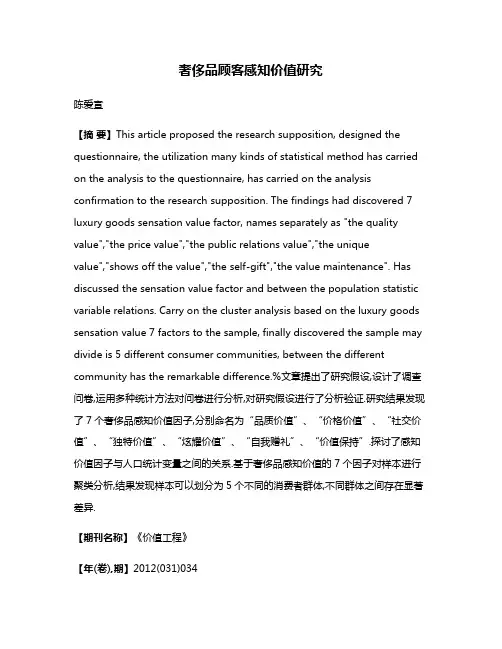
奢侈品顾客感知价值研究陈爱宣【摘要】This article proposed the research supposition, designed the questionnaire, the utilization many kinds of statistical method has carried on the analysis to the questionnaire, has carried on the analysis confirmation to the research supposition. The findings had discovered 7 luxury goods sensation value factor, names separately as "the quality value","the price value","the public relations value","the unique value","shows off the value","the self-gift","the value maintenance". Has discussed the sensation value factor and between the population statistic variable relations. Carry on the cluster analysis based on the luxury goods sensation value 7 factors to the sample, finally discovered the sample may divide is 5 different consumer communities, between the different community has the remarkable difference.%文章提出了研究假设,设计了调查问卷,运用多种统计方法对问卷进行分析,对研究假设进行了分析验证.研究结果发现了7个奢侈品感知价值因子,分别命名为“品质价值”、“价格价值”、“社交价值”、“独特价值”、“炫耀价值”、“自我赠礼”、“价值保持”.探讨了感知价值因子与人口统计变量之间的关系.基于奢侈品感知价值的7个因子对样本进行聚类分析,结果发现样本可以划分为5个不同的消费者群体,不同群体之间存在显著差异.【期刊名称】《价值工程》【年(卷),期】2012(031)034【总页数】3页(P177-179)【关键词】奢侈品;感知价值;因子;消费者类型【作者】陈爱宣【作者单位】浙江旅游职业学院,杭州311231【正文语种】中文【中图分类】F760 引言据世界奢侈品协会2011官方报告显示,截止2011年3月底,中国奢侈品市场消费总额占据全球份额的四分之一,中国已经成为全球奢侈品消费大国。
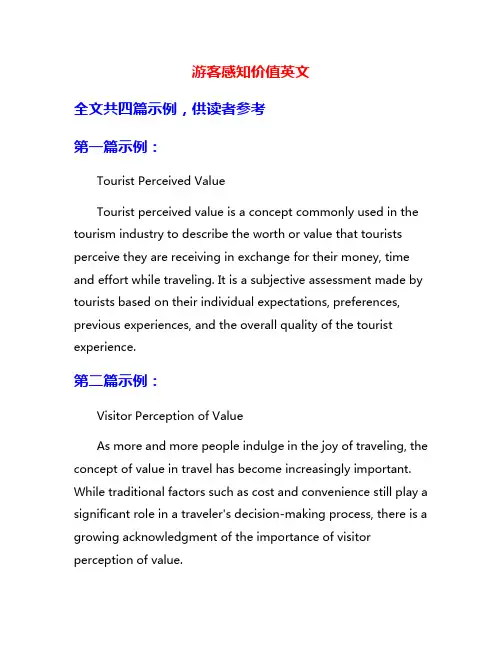
游客感知价值英文全文共四篇示例,供读者参考第一篇示例:Tourist Perceived ValueTourist perceived value is a concept commonly used in the tourism industry to describe the worth or value that tourists perceive they are receiving in exchange for their money, time and effort while traveling. It is a subjective assessment made by tourists based on their individual expectations, preferences, previous experiences, and the overall quality of the tourist experience.第二篇示例:Visitor Perception of ValueAs more and more people indulge in the joy of traveling, the concept of value in travel has become increasingly important. While traditional factors such as cost and convenience still play a significant role in a traveler's decision-making process, there is a growing acknowledgment of the importance of visitor perception of value.第三篇示例:【游客感知价值英文】In recent years, the value of tourism has become increasingly important as a driver of economic growth and development in many countries around the world. As more and more people travel for leisure and business, the demand for unique and authentic travel experiences has also increased. One key aspect of the tourism industry that has gained significance is the perception of value by tourists.Tourists' perception of value refers to the subjective assessment of the benefits and costs associated with a travel experience. It is influenced by a wide range of factors, including the quality of the service provided, the price of the product or service, and the overall satisfaction with the experience. Understanding and measuring tourists' perception of value is crucial for destinations and businesses in the tourism industry to attract and retain customers.There are several key dimensions of value that influence tourists' perception. These include:- Functional value: This refers to the tangible benefits that tourists receive from a travel experience, such as the quality ofaccommodation, transportation, and attractions. Tourists expect to receive good value for the money they spend on these basic services.- Emotional value: This refers to the emotional benefits that tourists derive from a travel experience, such as the sense of relaxation, happiness, and fulfillment. Positive emotional experiences can lead to greater satisfaction and loyalty among tourists.- Social value: This refers to the social benefits that tourists gain from interacting with other people during their travels, such as forming new relationships, sharing experiences, and building social connections. Social value can enhance the overall quality of the travel experience.- Symbolic value: This refers to the symbolic orstatus-related benefits that tourists associate with a travel experience, such as the prestige of staying at a luxury hotel or visiting a famous landmark. Symbolic value can enhance tourists' self-esteem and social status.- Experiential value: This refers to the unique and memorable experiences that tourists have during their travels, such as participating in cultural activities, trying new foods, andexploring natural attractions. Experiential value can create lasting memories and emotional connections with a destination.Tourists' perception of value is shaped by their expectations, preferences, and past experiences. It is influenced by factors such as the level of competition in the tourism industry, the quality of the destination's infrastructure and services, and the overall image and reputation of the destination. To enhance tourists' perception of value, destinations and businesses in the tourism industry can focus on improving the quality of their products and services, offering competitive prices, and creating unique and authentic travel experiences.In conclusion, tourists' perception of value plays a critical role in the success of the tourism industry. By understanding and meeting tourists' expectations and preferences, destinations and businesses can enhance their competitiveness and attract more visitors. Tourists' perception of value is a key driver of customer satisfaction, loyalty, and word-of-mouth promotion. It is essential for destinations and businesses in the tourism industry to prioritize and invest in creating value for tourists to ensure long-term success and sustainability.第四篇示例:Tourist Perceived ValueTourist perceived value is a concept that plays a significant role in the tourism industry. It refers to the perceived benefits and satisfaction that tourists receive from their travel experience in relation to the cost and effort involved in the trip. In other words, it is the perceived worth that tourists assign to a destination or a tourism product based on their overall experience.There are several factors that contribute to tourists' perceived value, including the quality of the destination, the services and facilities available, the authenticity of the experience, and the overall cost of the trip. For example, if a tourist visits a destination with stunning natural beauty, rich cultural heritage, and excellent hospitality, they are likely to perceive high value from their visit. On the other hand, if the destination is poorly maintained, lacks basic facilities, and has unfriendly locals, tourists are likely to perceive low value from their visit.Tourists' perceived value can also be influenced by their expectations, motivations, and personal preferences. For instance, a luxury traveler may value comfort, exclusivity, and personalized service, while an adventure traveler may value excitement, challenge, and new experiences. Therefore, it isimportant for tourism providers to understand the different needs and preferences of tourists in order to deliver a valuable and memorable experience.In today's competitive tourism market, it is essential for destinations and tourism providers to focus on enhancing tourists' perceived value in order to attract and retain visitors. This can be achieved by providing high-quality services and facilities, offering authentic and unique experiences, pricing products and services competitively, and engaging with tourists to gather feedback and improve the overall visitor experience.Moreover, digital technologies and social media play a crucial role in shaping tourists' perceived value. Online reviews, ratings, and recommendations from fellow travelers can greatly influence the perceived value of a destination or a tourism product. Therefore, destinations and tourism providers need to actively manage their online presence and reputation in order to enhance tourists' perception of value.In conclusion, tourist perceived value is a key concept in the tourism industry that influences tourists' decision-making, satisfaction, and loyalty. By focusing on enhancing tourists' perceived value through quality services, authentic experiences, competitive pricing, and active online presence, destinations andtourism providers can create positive and memorable travel experiences that will attract repeat visitors and positive word-of-mouth recommendations.。
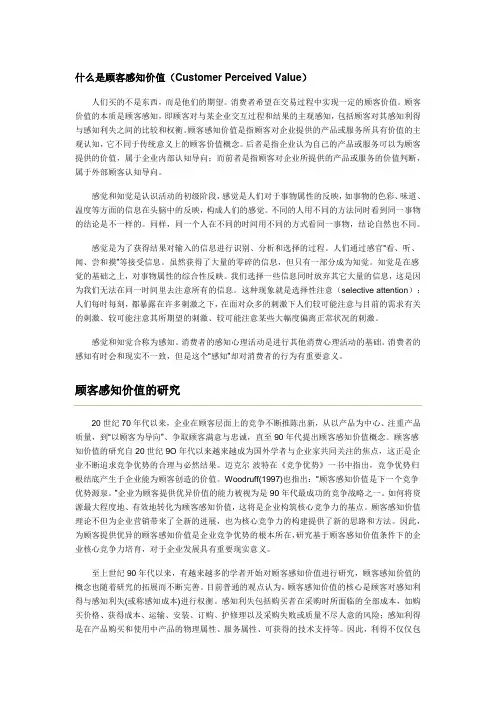
什么是顾客感知价值(Customer Perceived Value)人们买的不是东西,而是他们的期望。
消费者希望在交易过程中实现一定的顾客价值。
顾客价值的本质是顾客感知,即顾客对与某企业交互过程和结果的主观感知,包括顾客对其感知利得与感知利失之间的比较和权衡。
顾客感知价值是指顾客对企业提供的产品或服务所具有价值的主观认知,它不同于传统意义上的顾客价值概念。
后者是指企业认为自己的产品或服务可以为顾客提供的价值,属于企业内部认知导向;而前者是指顾客对企业所提供的产品或服务的价值判断,属于外部顾客认知导向。
感觉和知觉是认识活动的初级阶段,感觉是人们对于事物属性的反映,如事物的色彩、味道、温度等方面的信息在头脑中的反映,构成人们的感觉。
不同的人用不同的方法同时看到同一事物的结论是不一样的。
同样,同一个人在不同的时间用不同的方式看同一事物,结论自然也不同。
感觉是为了获得结果对输入的信息进行识别、分析和选择的过程。
人们通过感官“看、听、闻、尝和摸”等接受信息。
虽然获得了大量的零碎的信息,但只有一部分成为知觉。
知觉是在感觉的基础之上,对事物属性的综合性反映。
我们选择一些信息同时放弃其它大量的信息,这是因为我们无法在同一时间里去注意所有的信息。
这种现象就是选择性注意(selective attention):人们每时每刻,都暴露在许多刺激之下,在面对众多的刺激下人们较可能注意与目前的需求有关的刺激、较可能注意其所期望的刺激、较可能注意某些大幅度偏离正常状况的刺激。
感觉和知觉合称为感知。
消费者的感知心理活动是进行其他消费心理活动的基础。
消费者的感知有时会和现实不一致,但是这个“感知”却对消费者的行为有重要意义。
顾客感知价值的研究20世纪70年代以来,企业在顾客层面上的竞争不断推陈出新,从以产品为中心、注重产品质量,到“以顾客为导向”、争取顾客满意与忠诚,直至90年代提出顾客感知价值概念。
顾客感知价值的研究自20世纪9O年代以来越来越成为国外学者与企业家共同关注的焦点,这正是企业不断追求竞争优势的合理与必然结果。
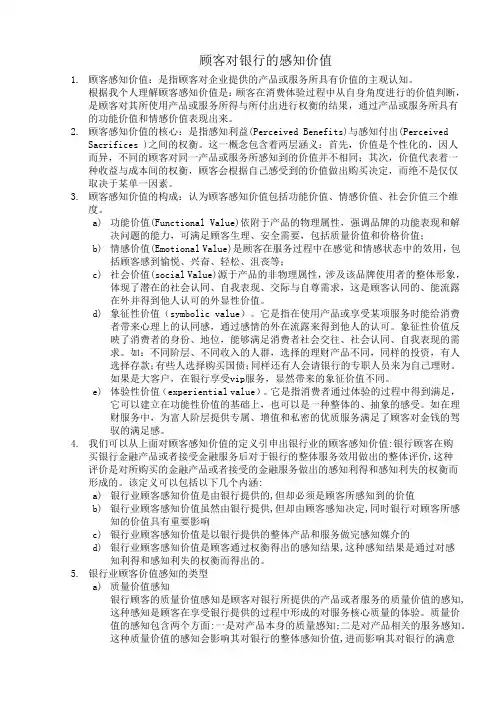
顾客对银行的感知价值1.顾客感知价值:是指顾客对企业提供的产品或服务所具有价值的主观认知。
根据我个人理解顾客感知价值是:顾客在消费体验过程中从自身角度进行的价值判断,是顾客对其所使用产品或服务所得与所付出进行权衡的结果,通过产品或服务所具有的功能价值和情感价值表现出来。
2.顾客感知价值的核心:是指感知利益(Perceived Benefits)与感知付出(PerceivedSacrifices )之间的权衡。
这一概念包含着两层涵义:首先,价值是个性化的,因人而异,不同的顾客对同一产品或服务所感知到的价值并不相同;其次,价值代表着一种收益与成本间的权衡,顾客会根据自己感受到的价值做出购买决定,而绝不是仅仅取决于某单一因素。
3.顾客感知价值的构成:认为顾客感知价值包括功能价值、情感价值、社会价值三个维度。
a)功能价值(Functional Value)依附于产品的物理属性,强调品牌的功能表现和解决问题的能力,可满足顾客生理、安全需要,包括质量价值和价格价值;b)情感价值(Emotional Value)是顾客在服务过程中在感觉和情感状态中的效用,包括顾客感到愉悦、兴奋、轻松、沮丧等;c)社会价值(social Value)源于产品的非物理属性,涉及该品牌使用者的整体形象,体现了潜在的社会认同、自我表现、交际与自尊需求,这是顾客认同的、能流露在外并得到他人认可的外显性价值。
d)象征性价值(symbolic value)。
它是指在使用产品或享受某项服务时能给消费者带来心理上的认同感,通过感情的外在流露来得到他人的认可。
象征性价值反映了消费者的身份、地位,能够满足消费者社会交往、社会认同、自我表现的需求。
如:不同阶层、不同收入的人群,选择的理财产品不同,同样的投资,有人选择存款;有些人选择购买国债;同样还有人会请银行的专职人员来为自己理财。
如果是大客户,在银行享受vip服务,显然带来的象征价值不同。
e)体验性价值(experiential value)。
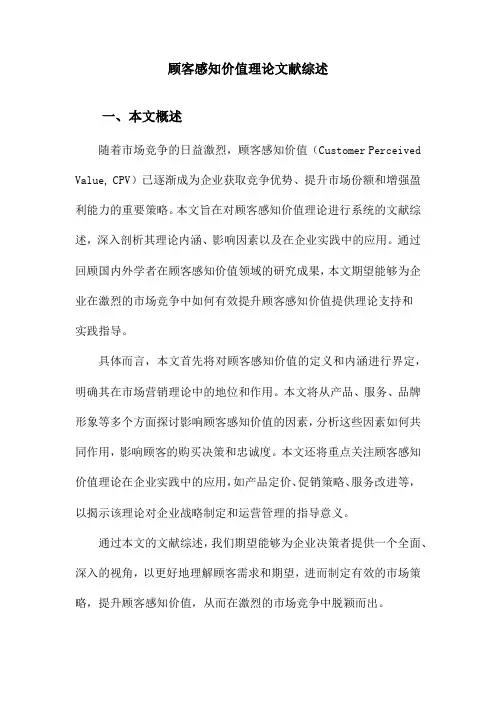
顾客感知价值理论文献综述一、本文概述随着市场竞争的日益激烈,顾客感知价值(Customer Perceived Value, CPV)已逐渐成为企业获取竞争优势、提升市场份额和增强盈利能力的重要策略。
本文旨在对顾客感知价值理论进行系统的文献综述,深入剖析其理论内涵、影响因素以及在企业实践中的应用。
通过回顾国内外学者在顾客感知价值领域的研究成果,本文期望能够为企业在激烈的市场竞争中如何有效提升顾客感知价值提供理论支持和实践指导。
具体而言,本文首先将对顾客感知价值的定义和内涵进行界定,明确其在市场营销理论中的地位和作用。
本文将从产品、服务、品牌形象等多个方面探讨影响顾客感知价值的因素,分析这些因素如何共同作用,影响顾客的购买决策和忠诚度。
本文还将重点关注顾客感知价值理论在企业实践中的应用,如产品定价、促销策略、服务改进等,以揭示该理论对企业战略制定和运营管理的指导意义。
通过本文的文献综述,我们期望能够为企业决策者提供一个全面、深入的视角,以更好地理解顾客需求和期望,进而制定有效的市场策略,提升顾客感知价值,从而在激烈的市场竞争中脱颖而出。
二、顾客感知价值的理论基础顾客感知价值理论起源于市场营销领域,其核心在于理解消费者如何从自身角度出发,对产品或服务进行价值评估。
这一理论的形成和发展,离不开多个学科的理论支撑和实践经验的积累。
经济学中的消费者行为理论为顾客感知价值提供了基础。
消费者行为理论指出,消费者在做出购买决策时,会基于自身需求、预算和偏好,对产品或服务的效用进行评估。
这种效用评估正是消费者感知价值的体现。
因此,顾客感知价值理论在经济学框架下,关注的是消费者如何根据自身需求和经济条件,对产品或服务进行价值判断。
心理学中的认知心理学也为顾客感知价值理论提供了重要支持。
认知心理学研究人类如何获取信息、处理信息并做出决策。
在顾客感知价值理论中,消费者的价值判断是一个心理过程,涉及到消费者对产品或服务的认知、情感反应和决策过程。
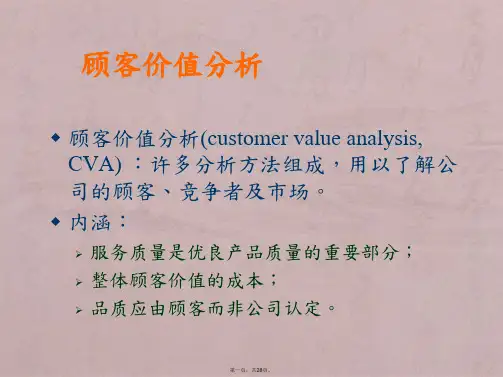
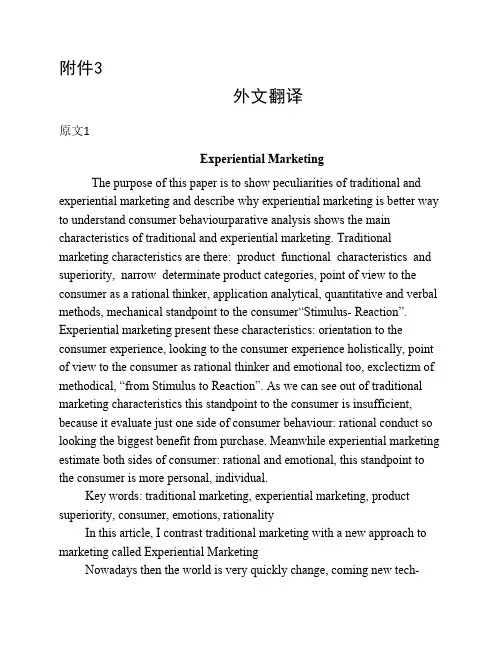
附件3外文翻译原文1Experiential MarketingThe purpose of this paper is to show peculiarities of traditional and experiential marketing and describe why experiential marketing is better way to understand consumer behaviourparative analysis shows the main characteristics of traditional and experiential marketing. Traditional marketing characteristics are there: product functional characteristics and superiority, narrow determinate product categories, point of view to the consumer as a rational thinker, application analytical, quantitative and verbal methods, mechanical standpoint to the consumer“Stimulus- Reaction”. Experiential marketing present these characteristics: orientation to the consumer experience, looking to the consumer experience holistically, point of view to the consumer as rational thinker and emotional too, exclectizm of methodical, “from Stimulus to Reaction”. As we can see out of traditional marketing characteristics this standpoint to the consumer is insufficient, because it evaluate just one side of consumer behaviour: rational conduct so looking the biggest benefit from purchase. Meanwhile experiential marketing estimate both sides of consumer: rational and emotional, this standpoint to the consumer is more personal, individual.Key words: traditional marketing, experiential marketing, product superiority, consumer, emotions, rationalityIn this article, I contrast traditional marketing with a new approach to marketing called Experiential MarketingNowadays then the world is very quickly change, coming new tech-nologies, communication, comes changes in to the marketing too. In the Great Britain, USA and similar counties markets are overfill with products and services. There are big competitions so principles and actions of traditional marketing do not work. How attract new consumers, cause? These opportunities have experiential marketing.Some propositions of traditional marketing are discussed. In the traditional marketing commodity is understanding as accomplice of attributes. K. Lancaster expressed this standpoint the first time in 1966. Then this standpoint was developing by F. Kotler, T. Nagle. In the newest science literature we can find good description as a complex of characteristics and superiority Many consumer behaviour researches such as Kotona, Engel, Black-well, Minard 1999 consumer estimate like rational thinker. This standpoint is based on concept of information remaking. This concept widely comes from cognitive psychology.Marketing-mix inventor Neil Borden 1964 asserts that united components in the marketing-mix are not. Marketing-mix theory was criticising due to its mechanical point of view stimulus- reaction. Now is proved that between stimulus and reaction is process.The notion of experience has entered the field of consumption and marketing through Holbrook and Hirschman’s 1982 pioneering article. Twenty years after, this notion has gained ground to be recognised as important for what it can contribute to marketing knowledge of the consumer. As a consequence, it is the pillar of the socalled experience economy and experiential marketing. Building on Arnould and Price’s well-known 93’s “River Magic” paper on extraordinary experiences, marketers tend to engage consumers in a memorable way, offering them extraordinary experiences. For them, experiences provide consumers a way to engage physically, mentally, emotionally, socially and spiritually in the consumption of the product orservice making the interaction meaningfully real.Experiential marketing is everywhere. In a variety of industries, companies have moved away from traditional "features-and-benefits" marketing toward creating experiences for their customers. This shift toward experiential marketing has occurred as a result of three simultaneous developments in the broader business environmentWith the experience economy era,with the increased competition is narrowing rather than as a natural advantage;Enterprises in product, pricing, channels and promotion, marketing services, operating at the level of competition, due to the operation of the market norms of transparency and information, and made to imitate and learn from each other at an increasing rate, I would like to establish long-term competitive advantage has become increasingly impossible;The various communication activities, and enhance the customer experience needs,so that customers receive the material and spiritual concept of the dual meet marketing - Experiential marketingIn many cases, customers may have turned a deaf ear to product advertising overwhelming. Because there are too many ads, and many advertising commitments to honor the integrity of a number of emerging issues, with the changes in values, the confidence of customers for the advertisers are increasingly reduced. In fact, customer care is reflected in the details of the real experience, a good brand in the details for customers to get real comfortable experience times in fact, a hundred times better than advertising Consumer value is the core of marketing attention to what customers value is the fundamental question of winning. Traditional textbook lists four kinds of consumer value, namely, functional value, emotional value, social value and personal value. At present, the company has "experience" to the "experience economy" brought about by the new value. "Consumerexperience" has become the first five kinds of consumer value, namely, the pursuit of consumer purchases and the value of the experience.1. Focus on Functional Features and BenefitsTraditional marketing is largely focused on features andbenefits.Traditional marketers assume that customers business customers or end consumers in a variety of markets industrial, consumer, technology, serviceWeigh fimctional features in tenns of their importance, trade off features by comparing them, and select the product with the highest overall utility defined as the sum of weighted features2.Product Category and Competition are Narrowly DefinedIn the world of a traditional marketer, McDonald's competes against Burger King and Wendy's and not against Pizza Hut Friendly's or Starbucks. Chanel fragrances compete ^igainst Dior fragrances and not against those of Lancome or L'Oreal, or against fragrances offered by the Gap or another mass-market retailer. For a traditional marketer, competition occurs primarily within narrowly defined product categories - the battleground of product and brand Managers.3. Customers are Viewed as Rational Decision MakersThroughout this century, economists, decision scientists and marketers have viewed customer decision-making as straightforward problem solving. As Engel, Blackwell and Miniard 1994 explain, problem solving refers to thoughtful, reasoned action undertaken to bring about need satisfaction.Customer decision-making processes typically ^lre assumed to involve severalsteps: need recognition, information search, evaluation of altematives, purchase and consumption.4. Methods and Tools are Analytical, Quantitative and Verbal Standardtraditional marketing methodologies are analytical, quantitative and verbal. Think about regression models. The input to most regression models and their stepchild the logit model consists of verbal ratings collected in interviews or surveys. The purpose is to predict purchase or choice based on a number of predictors and to assess their relative importance weights. Or consider positioning mapsA Focus on Customer ExperiencesIn contrast to its narrow focus on functional features andbenefits,experiential liarketing focuses on customer experiences. Experiences occur as a result of encountering, undergoing or living through tilings. Experiences provide sensory, emotional, cognitive, behavioural, and relational values that replace functional values.Strategic Experiential ModulesThe SENSE module - or SENSE marketing - appeals to the senses with the objective of creating sensory experiences, through sight, sound, touch, taste and smell. SENSE marketing may be used to differentiate companies and products, to motivate customers and to add value to products FEEL marketing appeals to customers' inner feelings and emotions, with the objective of creating affective experiences that range from mildly positive moods linked to a brandTHINK marketing appeals to the intellect with the objective of creating cognitive, problem-solving experiences that engage customers creatively THINK appeals to target customers' convergent and diver^gent thinking through surprise,intrigue and provocation.ACT marketing enriches customers' lives by targeting their physical experiences, showing them altemative ways of doing thingsRELATE marketing contains aspects of SENSE, FEEL, THINK and ACTMarketing. However, relate marketing expands beyond the individual's Personal。
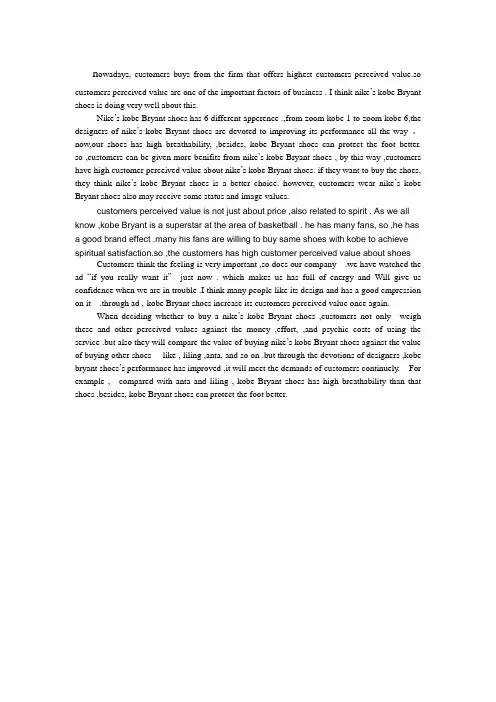
n owadays, customers buys from the firm that offers highest customers perceived value.socustomers perceived value are one of the important factors of business . I think nike’s kobe Bryant shoes is doing very well about this.Nike’s kobe Bryant shoes has 6 different apperence .,from zoom kobe 1 to zoom kobe 6,the designers of nike’s kobe Bryant shoes are devoted to improving its performance all the way ,now,our shoes has high breathability, ,besides, kobe Bryant shoes can protect the foot better. so ,customers can be given more benifits from nike’s kobe Bryant shoes , by this way ,customers have high customer perceived value about nike’s kobe Bryant shoes. if they want to buy the shoes, they think nike’s kobe Bryant shoes is a better choice. however, customers wear nike’s kobe Bryant shoes also may receive some status and image values.customers perceived value is not just about price ,also related to spirit . As we all know ,kobe Bryant is a superstar at the area of basketball . he has many fans, so ,he has a good brand effect .many his fans are willing to buy same shoes with kobe to achieve spiritual satisfaction.so ,the customers has high customer perceived value about shoes Customers think the feeling is very important ,so does our company .we have watched the ad “if you really want it”just now . which makes us has full of energy and Will give us confidence when we are in trouble .I think many people like its design and has a good empression on it .through ad ,kobe Bryant shoes increase its customers perceived value once again.When deciding whether to buy a nike’s kobe Bryant shoes ,customers not only weigh these and other perceived values against the money ,effort, ,and psychic costs of using the service .but also they will compare the value of buying nike’s kobe Bryant shoes against the value of buying other shoes----like , liling ,anta, and so on .but through the devotions of designers ,kobe bryant shoes’s performance has improved ,it will meet the demands of customers continuely. For example , compared with anta and liling , kobe Bryant shoes has high breathability than that shoes ,besides, kobe Bryant shoes can protect the foot better.。
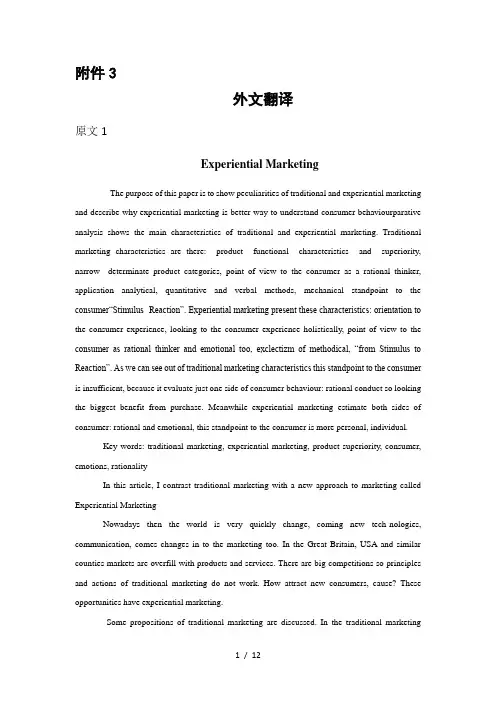
附件3外文翻译原文1Experiential MarketingThe purpose of this paper is to show peculiarities of traditional and experiential marketing and describe why experiential marketing is better way to understand consumer behaviourparative analysis shows the main characteristics of traditional and experiential marketing. Traditional marketing characteristics are there: product functional characteristics and superiority, narrow determinate product categories, point of view to the consumer as a rational thinker, application analytical, quantitative and verbal methods, mechanical standpoint to the consumer“Stimulus- Reaction”. Experiential marketing present these characteristics: orientation to the consumer experience, looking to the consumer experience holistically, point of view to the consumer as rational thinker and emotional too, exclectizm of methodical, “from Stimulus to Reaction”. As we can see out of traditional marketing characteristics this standpoint to the consumer is insufficient, because it evaluate just one side of consumer behaviour: rational conduct so looking the biggest benefit from purchase. Meanwhile experiential marketing estimate both sides of consumer: rational and emotional, this standpoint to the consumer is more personal, individual.Key words: traditional marketing, experiential marketing, product superiority, consumer, emotions, rationalityIn this article, I contrast traditional marketing with a new approach to marketing called Experiential MarketingNowadays then the world is very quickly change, coming new tech-nologies, communication, comes changes in to the marketing too. In the Great Britain, USA and similar counties markets are overfill with products and services. There are big competitions so principles and actions of traditional marketing do not work. How attract new consumers, cause? These opportunities have experiential marketing.Some propositions of traditional marketing are discussed. In the traditional marketing1 / 12commodity is understanding as accomplice of attributes. K. Lancaster expressed this standpoint the first time in 1966. Then this standpoint was developing by F. Kotler, T. Nagle. In the newest science literature we can find good description as a complex of characteristics and superiority Many consumer behaviour researches such as Kotona, Engel, Black-well, Minard 1999 consumer estimate like rational thinker. This standpoint is based on concept of information remaking. This concept widely comes from cognitive psychology.Marketing-mix inventor Neil Borden 1964 asserts that united components in the marketing-mix are not. Marketing-mix theory was criticising due to its mechanical point of view stimulus- reaction. Now is proved that between stimulus and reaction is process.The notion of experience has entered the field of consumption and marketing through Holbrook and Hirschman’s 1982 pioneering article. Twenty years after, this notion has gained ground to be recognised as important for what it can contribute to marketing knowledge of the consumer. As a consequence, it is the pillar of the socalled experience economy and experiential marketing. Building on Arnould and Price’s well-known 93’s “River Magic” paper on extraordinary experiences, marketers tend to engage consumers in a memorable way, offering them extraordinary experiences. For them, experiences provide consumers a way to engage physically, mentally, emotionally, socially and spiritually in the consumption of the product or service making the interaction meaningfully real.Experiential marketing is everywhere. In a variety of industries, companies have moved away from traditional "features-and-benefits" marketing toward creating experiences for their customers. This shift toward experiential marketing has occurred as a result of three simultaneous developments in the broader business environmentWith the experience economy era,with the increased competition is narrowing rather than as a natural advantage;Enterprises in product, pricing, channels and promotion, marketing services, operating at the level of competition, due to the operation of the market norms of transparency and information, and made to imitate and learn from each other at an increasing rate, I would like to establish long-term competitive advantage has become increasingly impossible;The various communication activities, and enhance the customer experience needs,so that customers receive the material and spiritual concept of the dual meet marketing - ExperientialmarketingIn many cases, customers may have turned a deaf ear to product advertising overwhelming. Because there are too many ads, and many advertising commitments to honor the integrity of a number of emerging issues, with the changes in values, the confidence of customers for the advertisers are increasingly reduced. In fact, customer care is reflected in the details of the real experience, a good brand in the details for customers to get real comfortable experience times in fact, a hundred times better than advertising Consumer value is the core of marketing attention to what customers value is the fundamental question of winning. Traditional textbook lists four kinds of consumer value, namely, functional value, emotional value, social value and personal value. At present, the company has "experience" to the "experience economy" brought about by the new value. "Consumer experience" has become the first five kinds of consumer value, namely, the pursuit of consumer purchases and the value of the experience.1. Focus on Functional Features and BenefitsTraditional marketing is largely focused on features and benefits.Traditional marketers assume that customers business customers or end consumers in a variety of markets industrial, consumer, technology, serviceWeigh fimctional features in tenns of their importance, trade off features by comparing them, and select the product with the highest overall utility defined as the sum of weighted features2.Product Category and Competition are Narrowly DefinedIn the world of a traditional marketer, McDonald's competes against Burger King and Wendy's and not against Pizza Hut Friendly's or Starbucks. Chanel fragrances compete ^igainst Dior fragrances and not against those of Lancome or L'Oreal, or against fragrances offered by the Gap or another mass-market retailer. For a traditional marketer, competition occurs primarily within narrowly defined product categories - the battleground of product and brand Managers.3. Customers are Viewed as Rational Decision MakersThroughout this century, economists, decision scientists and marketers have viewed customer decision-making as straightforward problem solving. As Engel, Blackwell and Miniard 1994 explain, problem solving refers to thoughtful, reasoned action undertaken to bring about need satisfaction.Customer decision-making processes typically ^lre assumed to involve several3 / 12steps: need recognition, information search, evaluation of altematives, purchase and consumption.4. Methods and Tools are Analytical, Quantitative and V erbal Standard traditional marketing methodologies are analytical, quantitative and verbal. Think about regression models. The input to most regression models and their stepchild the logit model consists of verbal ratings collected in interviews or surveys. The purpose is to predict purchase or choice based on a number of predictors and to assess their relative importance weights. Or consider positioning mapsA Focus on Customer ExperiencesIn contrast to its narrow focus on functional features and benefits,experiential liarketing focuses on customer experiences. Experiences occur as a result of encountering, undergoing or living through tilings. Experiences provide sensory, emotional, cognitive, behavioural, and relational values that replace functional values.Strategic Experiential ModulesThe SENSE module - or SENSE marketing - appeals to the senses with the objective of creating sensory experiences, through sight, sound, touch, taste and smell. SENSE marketing may be used to differentiate companies and products, to motivate customers and to add value to products FEEL marketing appeals to customers' inner feelings and emotions, with the objective of creating affective experiences that range from mildly positive moods linked to a brand THINK marketing appeals to the intellect with the objective of creating cognitive, problem-solving experiences that engage customers creatively THINK appeals to target customers' convergent and diver^gent thinking through surprise,intrigue and provocation.ACT marketing enriches customers' lives by targeting their physical experiences, showing them altemative ways of doing thingsRELATE marketing contains aspects of SENSE, FEEL, THINK and ACTMarketing. However, relate marketing expands beyond the individual's Personal。

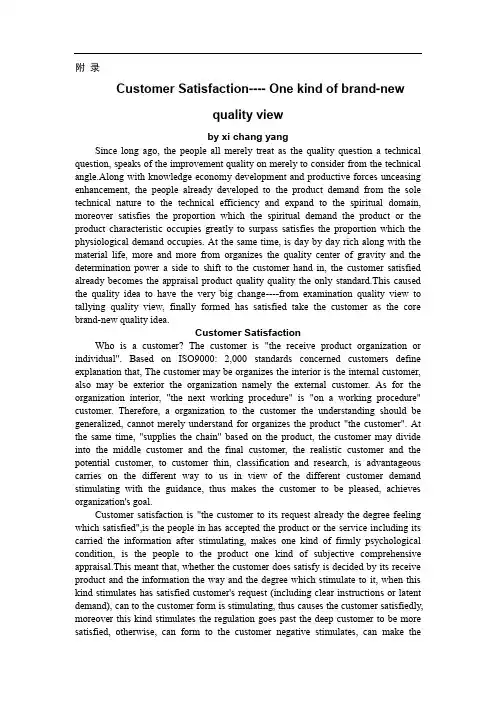
附录Customer Satisfaction---- One kind of brand-newquality viewby xi chang yangSince long ago, the people all merely treat as the quality question a technical question, speaks of the improvement quality on merely to consider from the technical angle.Along with knowledge economy development and productive forces unceasing enhancement, the people already developed to the product demand from the sole technical nature to the technical efficiency and expand to the spiritual domain, moreover satisfies the proportion which the spiritual demand the product or the product characteristic occupies greatly to surpass satisfies the proportion which the physiological demand occupies. At the same time, is day by day rich along with the material life, more and more from organizes the quality center of gravity and the determination power a side to shift to the customer hand in, the customer satisfied already becomes the appraisal product quality quality the only standard.This caused the quality idea to have the very big change----from examination quality view to tallying quality view, finally formed has satisfied take the customer as the core brand-new quality idea.Customer SatisfactionWho is a customer? The customer is "the receive product organization or individual". Based on ISO9000: 2,000 standards concerned customers define explanation that, The customer may be organizes the interior is the internal customer, also may be exterior the organization namely the external customer. As for the organization interior, "the next working procedure" is "on a working procedure" customer. Therefore, a organization to the customer the understanding should be generalized, cannot merely understand for organizes the product "the customer". At the same time, "supplies the chain" based on the product, the customer may divide into the middle customer and the final customer, the realistic customer and the potential customer, to customer thin, classification and research, is advantageous carries on the different way to us in view of the different customer demand stimulating with the guidance, thus makes the customer to be pleased, achieves organization's goal.Customer satisfaction is "the customer to its request already the degree feeling which satisfied",is the people in has accepted the product or the service including its carried the information after stimulating, makes one kind of firmly psychological condition, is the people to the product one kind of subjective comprehensive appraisal.This meant that, whether the customer does satisfy is decided by its receive product and the information the way and the degree which stimulate to it, when this kind stimulates has satisfied customer's request (including clear instructions or latent demand), can to the customer form is stimulating, thus causes the customer satisfiedly, moreover this kind stimulates the regulation goes past the deep customer to be more satisfied, otherwise, can form to the customer negative stimulates, can make thecustomer not to be pleased, moreover the regulation which stimulates to the customer goes past the depth, the customer is more unsatisfied, can cause the customer to complain, even the customer sues.Likes us to purchase clothes, clothes use value self-evident (winter clothing maintaining warmth, summer clothing penetrability and cool and so on), if only this but the oneself, the customer responded can be very light, but, if to the clothing assembly by the natural novel design, dresses up Li's color, causes us to obtain the accident pleasantly surprised, then can make us to feel one kind of unexpected harvest, we will be satisfied.Customer satisfactory quality view" Customer satisfaction " took one idea, more and more accepts for the multitudinous different type organization. We may understand from following several aspects that,1,the customer satisfies not only is the organization the starting point also falls the foot spot.The Chinese economy comprehensively entered "is too much economical" the time.Statistics have indicated, the consumer wants to choose the refrigerator from 290 kind of refrigerators, chooses the beer from 455 kind of beer, chooses the cosmetics from 478 kind of cosmetics, chooses the shirt from 575 kind of shirts. The price, the quality, the design all day after day hasten with. The buyer market buyer can make the decision.The customer decided wants any, when wants, how wants, to leave how many prices, the customer truly becomes the basic condition organizes depends on, the customer to satisfy the basic power which into the human society develops. Any organization when provides the product or the service, its goal lies in the product or the service which causes it to provide obtains customer's approval, and lets it be glad accepts. This requests the organization to understand the customer needs any type the product and the service, has any type to the product and the service the request---- The fine product, the customer does not need, also cannot obtain customer's approval. Therefore, the organization only had has grasped this starting point, could provide satisfaction for the customer the product or the service. At the same time, the customer satisfies the degree had decided the organization makes money the degree, had decided the organization develops mentality, according to conventional algorithm, an enterprise if preserves 5% stable customer, that this enterprise's profit at least can increase 25%. Therefore, the organization falls foot also to be supposed to lie in causes the customer satisfiedly, only had grasps "the customer to be satisfied" this driving force, the organization can obtain the considerable development.2, " Customer Satisfaction " is the market economy development necessity.The customer satisfies quality view is the market economy development inevitable result. Along with the social productive forces development, the society has brought the extremely rich material resources for the people, thus let the market realize from the seller market to the buyer market transformation, caused the buyer is the customer control the market development direction. Is passing we often by "mineproduct is qualified, customer do not use when" performs to shift responsibility onto others. Now not good, you think own product qualified, but cannot meet my needs, which you on saved in yours warehouse are being good! Who had considered my demand, whose product I do purchase. At the same time, the knowledge economy development enable the organization to have the ability to have the condition not only to satisfy customer's physiological needs, also can meet customer's psychological needs, causes the product to be more richly colorful, causes the service even more to look after with great solicitude.3,Customer satisfaction is the inevitable result which the humanist idea popularizes.The customer satisfies quality view is by the artificial starting point and the center, is revolving the reassignment organization and customer's enthusiasm, the activity, causes the organization unceasingly to satisfy the customer to request, thus realizes the customer to be satisfied, unceasingly realizes the humanity to the happy pursue, improves humanity's quality of life. At the same time, satisfies take the customer as the idea from organizes the quality specification and the determination power a side to change to a customer side, had reflected person's status unceasingly is enhancing. Grasps humanist this "the new melody", persisted according to customer's objective request, wants, for suffices to the foot; Does not want, does not give. Thus and mutually seeps the Chinese Communist Party in the organization and customer's interaction with to build humanity's matter and the spiritual civilization life.4, Customer satisfaction is organizes the eternal pursue the goal.Customer satisfaction is human society's one kind of basic desire, will be the humanity forever the without limits self- pursue. Therefore, meets customer's need and the desire also is organizes the eternal pursue the goal. Enters for the 21st century, the more and more many organization attention "the customer is satisfied" strategic sense. Is the various countries' expert, the entrepreneur, how the administrative personnels all exploring causes own organization to seize the 21st century quality as soon as possible the commanding point, many large-scale organization are formulating the 21st century quality strategies, and "the customer will be satisfied" took the quality strategy the core, took it will support other contents "the outline". "Satisfies customer's request and expected" will substitute for the pursue quality to be qualified or the service reaches the sign to become the highest goal which the enterprise pursues. Grasps the tendency to be able to grasp successfully, thus will grasp the future. In this competition extremely intense time, only has grasps this kind of tendency and the direction, correctly establishes the oneself developmental strategy goal, can in the competition neutrality to the invincible position.How stimulates the customer to be satisfied?Above said, customer satisfaction was the customer has accepted one kind of psychological condition which the product or the service and its the information stimulated produces, was a psychology concept. Then, how we do stimulate customer's this kind of satisfactory mood? "We do well, the customer will satisfy" to? Which first should we pay attention affect customer satisfaction and not the satisfactory factor have:1, not satisfactory factorThe clear instructions forgives which in the product either the service or anticipated provides to customer's use or the service, is the customer thought the self-evident characteristic, it meets the customer need the degree, affects the factor which the customer satisfies, once has the aspect which does not arrive, can create customer's disaffection, usually is called it not the satisfactory factor. For instance: We buy a thermos bottle, its heat preservation characteristic (or said use) is a not satisfactory factor. If buys a thermos bottle not to keep warm, we will be very annoyed and not be unsatisfied, since these characteristics all had, conforms to our requirement, also cannot urge us to satisfy, because we can think this is should.2, neutral factorSome one kind of factor, when customer's demand has not obtained satisfies, will feel very disappointedly; If obtains time satisfying which should obtain, cannot have any intense reflection; But, if organizes to do very much arrives, can increase the customer to be satisfied. We call such factor the neutral factor. For instance agrees time purchase goods, if cannot as scheduled arrive, can cause the customer to complain; If arrives on time, perhaps the customer cannot have any response; If can arrive ahead of time, then the customer can be very happy.3, satisfactory factorThe customer obtains the accident harvest, often can make the customer to be extremely pleased, however, organizes not to provide these product characteristics, also cannot cause the customer to be discontented, we called such factor is the satisfactory factor. For instance we purchase the ultra value service which the product obtained arrives; Enjoys when the service obtained arrives the accident present presents and so on. These accidents are pleasantly surprised often can make us to feel extremely satisfies.Had understood these affect the factor which the customer satisfies, how can we grasp well stimulate the customer to be satisfied. Only dodges forms the customer not satisfactory factor, diligently completes the neutral factor, plans with every effort with the implementation lets the factor which the customer satisfies, can unceasingly satisfy the customer to request, to strengthen the customer to be satisfied, thus achieves the quality goal which the customer satisfies, the promotion enterprise's development.The enterprise should establish and implement the customersatisfactory strategyWe do not avoid the enterprise the goal are the profit maximization. But the enterprise profit goal realization is take customer's existence as the foundation, left the customer, any organization all with difficulty exists. In in the 21st century competitions, who wins customer's adoring with the repayment, who can survive and the development; Otherwise, only can be blind alley. How does customer's adoring with repay, how also is decided to the enterprise causes their satisfaction. Therefore, says from some kind of degree, enterprise's management strategy is the quality strategy, but this all starting points and the home to return to all conclusion is a point: The customer is satisfied. How then we do establish and implement the customersatisfactory strategy?1, the creation " Customer satisfaction " as the central enterprise new management idea.The enterprise must manifests in own management policy and the goal "attracts more customers" and "unceasingly enhances the customer degree of satisfaction" the thought, in educates training to the staff in the foundation, causes the staff to comply with the occupational ethics, the behavior standards, the value idea and the staff quality molds the aspect, all seeps "all to let the customer is satisfied" the idea. Thus creates one kind in the enterprise interior "the internal service" management idea, although you not directly serve the customer, but your work must be for serves customer's person to serve. Inducts " the next working procedure in the enterprise interior is on the working procedure customer" the customer satisfies the idea, namely in the entire operation link, the previous link department treats as the next link department the customer, carries on the service to it, a link serves a link, finally provides the best service for the external customer.2, the promotion " Customer satisfaction " as the objective quality control innovation.The enterprise must frequently organized carry on the customer demand and the market information diagnosis, comprehensively, thoroughly and accurately grasps the customer various aspects the demand, including the latent demand, for the enterprise product market localization, the development design, the improvement and the innovation promptly provides the basis. At the same time, the diagnosis will obtain customer related aspect the and so on product function, quality, price and outward appearance demand, comprehensively accurately will transform as the product design improvement technical parameter, the cost element, and in strictly will request in the process according to the product design or the improvement which the organization will produce, will have to implement "under a link will be the customer" the policy, comprehensive development "internal customer satisfied" the activity, will produce conforms to the product which the customer will request, achieved the customer will be satisfied.3, pays special attention " Customer satisfaction " and serves the management innovation as the criterion enterprise marketing.The enterprise must use the science the method to carry on the customer degree of satisfaction to the enterprise exterior market environment evaluating after testing, through evaluates after testing the customer to enterprise's product quality characteristic, the fine reputation, well-knownness, turning head rate, the sales ability, the complaint rate and so on several aspects satisfaction, provides the basis for the improvement marketing strategy and the enhancement grade of service. At the same time, from enhances the customer "satisfaction" and "the loyalty" the goal embarks, establishes the customer file, omni-directionally implements, the multi- forms standard post-sale service, the realization pre-sale consultation, sells supports, the post-sale increment namely "the help user buys goods" the increment service process, thus "sues" the service after three stages entire processes service substitution.4, takes take " Customer satisfaction " as the guidance enterpriseinformation management innovation.The information technology development, provided the very good condition for our effectively collection and the process information, the enterprise has had in the realization take the enterprise as the center to take the customer as in the central mentality transformation foundation, carried on the enterprise information management the innovation. To the enterprise inside and outside pitch point and the flow and so on information collection, analysis, transmission, feedback, processing design, the speed which as well as various pitch points information current capacity and pasts performs to control, does the system research to the information feedback processing cycle and the time stipulation, thus is the correct development "the customer is satisfied" a series of activities, provides the science effective basis.5, the implementation " Customer satisfaction " as the master line enterprise organizational structure reorganization.While "the customer satisfied" the thought and "the customer satisfied" for the central strategy implementation, the enterprise must take the information bidirectional transmission speed, the information past the attrition rate and the management efficiency three big targets is in the synthesis optimization as a principle, reduces the enterprise excessively many management structure level and the administrative personnel level, causes the enterprise the structure flatly, the decision-making is fast. Realizes "the customer satisfiedly" the management goal is a master line, reasonably adjusts various departments the management function, eliminates the overlap region ofvarious departments function connection place and other management pessimistic areas, the realization management science is highly effective. Thus carries on the enterprise organizational structure the reorganization, the realization enterprise flow makes again.顾客满意——一种全新的质量观杨希昌长期以来,人们都把质量问题仅仅当作一个技术问题,说到改进质量就仅仅从技术角度去考虑。
Reviewing and conceptualisingcustomer-perceived valueConnie Chang, Meiji University, Japan*Sally Dibb, The Open University Business Schooi, UK顾客感知价值关心的是希望做出合理购物选择的消费者,从业者迫切,研究人员试图澄清顾客感知价值的概念基础和它同其他市场变量之间关系。
本文从营销学、经济学、价值论和心理学中合成文献,提供了顾客感知价值概念的整体回顾。
借助这些资源促进对顾客感知价值更深的理解和概念化。
具体地说,本文旨在了解服务和新的购物环境下的顾客感知价值,如在线设置。
对研究人员和经理们的影响都考虑在内。
关键词:顾客感知价值、价值论、心理学、经济学、营销学介绍消费者所购买产品和服务是消费者购买过程的结果,在这期间个人评估得到所需产品和服务的效益与成本。
在这个过程中,对这些项目做出的价值判断成为消费者决策的核心时,价值关心的是:希望做出合理购物选择的消费者、希望提高客户对价值认知的从业者、试图澄清顾客感知价值的概念基础和它同其他市场变量之间关系的研究人员。
之前的工作引发了对复杂性和发散构造的关注(Rust & Oliver, 1994)。
并不是独立地成为截然不同的概念,顾客感知价值是与价格、质量、付出的代价和满意度密切相关的,而与个人价值观联系相对更弱(Holbrook, 1999; Rokeach, 1973)。
这个概念可以从不同的角度被检查:客户的观点,股东的观点,关于价值链,或来自b2b的观点。
本文采用的是Gale (1994)的论点:他把价值看作客户对由组织提供的产品/服务的看法,同竞争公司提供的可用的产品/服务进行比较。
作为客户的视图提供的产品/服务的组织而那些可以从相互竞争的公司。
不管是来自不同学科的研究者还是商业从业人员,均对顾客感知价值越来越感兴趣。
如何提升顾客的感知价值顾客感知价值(CustomerPerceivedValue,CPV)就是顾客所能感知到的利益与其在获取产品或服务时所付出的成本进行权衡后对产品或服务效用的总体评价。
顾客感知价值体现的是顾客对企业提供的产品或服务所具有价值的主观认知,而区别于产品和服务的客观价值。
提高顾客感知价值的基本策略1、在控制成本的基础上,尽可能增加产品功能如果一个企业的某一种产品,比其他企业同类同价格的产品多出一个以上的有用功能,我们可以把这“多”出的功能看作是提高顾客感知价值的超值服务,即超出市场上同类同价产品的性价比的服务价值。
2、让产品使用时更安全由于现在市场上的问题产品太多,所以消费者在购买产品时就有很多忧虑,主要有:担心产品危及人身安全,如食物和药品中毒、致癌;产品过保修期(对有保修期的产品而言)后基本不能用,产品故障频发等等。
产品安全成了顾客感知价值越来越重要的组成部分,在由产品引起的安全事故频繁暴光的背景下更是如此。
企业可以利用专门知识和技术把产品设计得更安全。
如果更安全的产品同其他同类产品相比,价格高出不了多少,这也可理解为一种超值服务,因为该产品的性价比高。
3、使产品的非核心价值更高比如企业通过周密、细致的调查研究,使产品的外观、颜色、名称、包装等方面十分符合顾客的需求,则会提高顾客感知价值。
广州本田轿车与同档次轿车相比,造价并没有高出多少,质量、功能也相近,但由于它豪华、大气的外形满足了消费者的心理需求,因此在市场上十分走俏,其结果让日方都感到惊奇。
4、尽可能多地向顾客传达产品或服务的真实信息即让顾客从物有所值、没被欺骗的认识角度产生更高的感知价值。
5、降低产品成本及销售价格企业可以通过不断扩大生产规模或销售量来做到这一点。
这样也可以使买到价廉物美产品的顾客感到更多的利得。
6、为顾客提供关联或互补产品这样可以让顾客多一分付出,多十分回报。
7、以准确的品牌定位满足顾客心理与情感需求“金利来”领带和“万宝路”香烟就是成功地运用了这一策略而成为经典营销案例的。
顾客感知价值(customer-perceivedvalue)指与其他竞争产品相比,顾客拥有或使用某一种市场提供物的总利益与总成本之间的差异。
例如,“溢价牛仔”最近将牛仔裤的价格抬上了天。
一条佩奇溢价牛仔(paigepremiumdenim)的牛仔裤起价169美元。
一位购买了一条佩奇牛仔裤的女士认为物有所值。
佩奇的主人和设计者亚当斯·凯勒(adams-geller)运用她作为一名牛仔裤模特时学到的知识,完全从女性的角度设计牛仔裤。
佩奇说道:“我们中的大多数人没有完美的基因,但是我们可以带给你另一件最好的东西:完美的牛仔裤。
”她的牛仔裤“会提升臀部,使你的腿显得修长,大腿和臀部显得苗条——对所有女性关心的细节和质量都一丝不苟”。
总而言之,佩奇牛仔裤是一种真正的价值——它将更好也更长久地适合你。
当决定是否购买时,顾客会在拥有一条佩奇牛仔裤的这些利益和其他感知价值与获得它所付出的金钱和心理代价之间进行权衡。
顾客常常不能准确地或客观地判断价值和成本。
他们根据自己感知的价值作出判断。
例如,与一条你从盖普公司(gap)的货架上拉出来的便宜的牛仔裤相比,佩奇牛仔裤真正提供了卓越的质量和那么完美的修身效果吗?即使是这样,它值这么高的价格吗?这都是个人价值感知的事情,但大多数女性给予了肯定的回答。
一位女士说,对于她,溢价牛仔看起来总是恰好合身,价格因此不那么重要。
“我工作,所以我有钱买得起它,”她说,“我认为它值那么多钱。
”。
(精品)顾客感知价值对中国消费者购买行为影响——以上海手机市场为例顾客感知价值对中国消费者购买行为影响——以上海手机市场为例【原文出处】北京邮电大学学报:社会科学版【原刊期号】20092【原刊页号】46~51【分类号】F513【分类名】市场营销(理论版)【复印期号】200908【英文标题】Influence of Customer Perceived Value on Purchase Behaviors of Chinese Customers: Evidence from the Mobile Phone Market of Shanghai【标题注释】基金项目:国家自然科学基金重点项目(70832004)。
【作者】潘煜/高丽/王方华【作者简介】潘煜,华东理工大学商学院,管理科学博士。
(上海 200237);高丽,法国雷恩第一大学管理学院。
(雷恩 35000);王方华,上海交通大学安泰与经济管理学院。
(上海 200052)【内容提要】主要研究顾客感知价值对中国消费者购买行为的影响。
首先选择手机作为研究对象,上海作为样本的选择地点,在问卷调查的基础上,借助探索性因子分析和确认性因子分析,获得并验证了顾客感知价值度量量表;然后用结构方程模型对顾客感知价值与购买行为之间的关系进行了研究,详细分析了顾客感知价值各因子与购买行为之间的内在联系;最后,根据研究结果从顾客感知价值的视角提出了一个营销策略,帮助企业针对消费群体,定位、设计、生产、完善产品和实施有效的市场营销策略。
【英文摘要】This research aims to investigate the influences of customer perceived values on Chinese consumer behaviors. The empirical research has been conducted in the context of mobile phone markets in Shanghai. On the basis of large scale questionnaire survey, through exploratory and confirmatory factor analyses, the measurement scale of customer perceived values are created and validated. The relationship of customer perceived values and Chinese consumer behaviors is tested in the structural equation model and the influences of all the factors of customer perceived values on Chinese consumer behaviors are discussed in details. Based on the research results, the author proposes a new market segmentation method from the perspective of customer perceived values aiming to help marketers design and position their products, and develop and implement their marketing strategies more effectively.【关键词】手机/顾客感知价值/购买行为/结构方程mobile phone/customer perceived values/consumerbehaviors/structural equation model【正文】顾客感知价值是影响消费者购买行为的最直接因素。
顾客价值理论载瑟摩尔的可感知价值理论美国服务营销领域的著名学者瓦拉瑞尔·A ·载瑟摩尔(Valarie A.Zaithaml,1988)认为,顾客价值就是顾客感知价值CPV(Customer PerceivedValue),是顾客所能感知到的利益与其在获取产品或服务时所付出的成本进行权衡后对产品或服务效用的总体评价他从以下四个方面来阐释顾客感知价值:价值就是低廉的价格;价值就是我想从产品中所获取的东西;价值就是我付钱买回的质量;价值就是我的全部付出所能得到的全部。
这一概括包含着两层含义:首先,价值是由顾客决定的,具有个性化的特点。
不同的顾客对同一产品和服务所感知到的价值并不相同;其次,价值代表着一种效用(收益F)与成本(代价C)间的权衡,顾客会根据自己感受到的价值(V)做出购买决定,而不是仅仅取决于某个单一因素。
科特勒的可让渡价值理论菲利普·科特勒(Philip Kotler)是从顾客让渡价值和顾客满意的角度来阐述顾客价值的。
科特勒指出,顾客能够判断哪些供应品将提供最高价值。
在一定的搜寻成本和有限的知识、灵活性和收入等因素的限定下,顾客是价值最大化的追求者。
他们形成t种价值期望,并根据它行动。
他们会了解供应品是否符合他们的期望价值,这将影响他们的满意和再购买的可能性。
他认为,对顾客研究的前提是,顾客将从那些他们认为能提供最高顾客让渡价值的公司购买商品。
顾客让渡价值(customer delivered value)是指总顾客价值与总顾客成本之差。
总顾客价值(total customer value)就是顾客从某一特定产品或服务中获得的一系列利益,它包括产品价值、服务价值、人员价值和形象价值等。
顾客总成本(total customer cost)是指顾客在评估、获得和使用该产品或服务时而引起的顾客预计费用,顾客总成本包括货币成本、时间成本、精神成本和体力成本。
注:(此图中间第二个框为顾客总成本)格朗鲁斯的顾客价值过程理论1996 年以来,克里斯汀·格朗鲁斯(Chrigtian Gronroos)从关系营销的角度阐述顾客价值的内涵。
附件3外文翻译原文1Experiential MarketingThe purpose of this paper is to show peculiarities of traditional and experiential marketing and describe why experiential marketing is better way to understand consumer behaviourparative analysis shows the main characteristics of traditional and experiential marketing. Traditional marketing characteristics are there: product functional characteristics and superiority, narrow determinate product categories, point of view to the consumer as a rational thinker, application analytical, quantitative and verbal methods, mechanical standpoint to the consumer“Stimulus- Reaction”. Experiential marketing present these characteristics: orientation to the consumer experience, looking to the consumer experience holistically, point of view to the consumer as rational thinker and emotional too, exclectizm of methodical, “from Stimulus to Reaction”. As we can see out of traditional marketing characteristics this standpoint to the consumer is insufficient, because it evaluate just one side of consumer behaviour: rational conduct so looking the biggest benefit from purchase. Meanwhile experiential marketing estimate both sides of consumer: rational and emotional, this standpoint to the consumer is more personal, individual.Key words: traditional marketing, experiential marketing, product superiority, consumer, emotions, rationalityIn this article, I contrast traditional marketing with a new approach to marketing called Experiential MarketingNowadays then the world is very quickly change, coming new tech-nologies, communication, comes changes in to the marketing too. In the Great Britain, USA and similar counties markets are overfill with products and services. There are big competitions so principles and actions of traditional marketing do not work. How attract new consumers, cause? These opportunities have experiential marketing.Some propositions of traditional marketing are discussed. In the traditional marketingcommodity is understanding as accomplice of attributes. K. Lancaster expressed this standpoint the first time in 1966. Then this standpoint was developing by F. Kotler, T. Nagle. In the newest science literature we can find good description as a complex of characteristics and superiority Many consumer behaviour researches such as Kotona, Engel, Black-well, Minard 1999 consumer estimate like rational thinker. This standpoint is based on concept of information remaking. This concept widely comes from cognitive psychology.Marketing-mix inventor Neil Borden 1964 asserts that united components in the marketing-mix are not. Marketing-mix theory was criticising due to its mechanical point of view stimulus- reaction. Now is proved that between stimulus and reaction is process.The notion of experience has entered the field of consumption and marketing through Holbrook and Hirschman’s 1982 pioneering article. Twenty years after, this notion has gained ground to be recognised as important for what it can contribute to marketing knowledge of the consumer. As a consequence, it is the pillar of the socalled experience economy and experiential marketing. Building on Arnould and Price’s well-known 93’s “River Magic” paper on extraordinary experiences, marketers tend to engage consumers in a memorable way, offering them extraordinary experiences. For them, experiences provide consumers a way to engage physically, mentally, emotionally, socially and spiritually in the consumption of the product or service making the interaction meaningfully real.Experiential marketing is everywhere. In a variety of industries, companies have moved away from traditional "features-and-benefits" marketing toward creating experiences for their customers. This shift toward experiential marketing has occurred as a result of three simultaneous developments in the broader business environmentWith the experience economy era,with the increased competition is narrowing rather than as a natural advantage;Enterprises in product, pricing, channels and promotion, marketing services, operating at the level of competition, due to the operation of the market norms of transparency and information, and made to imitate and learn from each other at an increasing rate, I would like to establish long-term competitive advantage has become increasingly impossible;The various communication activities, and enhance the customer experience needs,so that customers receive the material and spiritual concept of the dual meet marketing - ExperientialmarketingIn many cases, customers may have turned a deaf ear to product advertising overwhelming. Because there are too many ads, and many advertising commitments to honor the integrity of a number of emerging issues, with the changes in values, the confidence of customers for the advertisers are increasingly reduced. In fact, customer care is reflected in the details of the real experience, a good brand in the details for customers to get real comfortable experience times in fact, a hundred times better than advertising Consumer value is the core of marketing attention to what customers value is the fundamental question of winning. Traditional textbook lists four kinds of consumer value, namely, functional value, emotional value, social value and personal value. At present, the company has "experience" to the "experience economy" brought about by the new value. "Consumer experience" has become the first five kinds of consumer value, namely, the pursuit of consumer purchases and the value of the experience.1. Focus on Functional Features and BenefitsTraditional marketing is largely focused on features and benefits.Traditional marketers assume that customers business customers or end consumers in a variety of markets industrial, consumer, technology, serviceWeigh fimctional features in tenns of their importance, trade off features by comparing them, and select the product with the highest overall utility defined as the sum of weighted features2.Product Category and Competition are Narrowly DefinedIn the world of a traditional marketer, McDonald's competes against Burger King and Wendy's and not against Pizza Hut Friendly's or Starbucks. Chanel fragrances compete ^igainst Dior fragrances and not against those of Lancome or L'Oreal, or against fragrances offered by the Gap or another mass-market retailer. For a traditional marketer, competition occurs primarily within narrowly defined product categories - the battleground of product and brand Managers.3. Customers are Viewed as Rational Decision MakersThroughout this century, economists, decision scientists and marketers have viewed customer decision-making as straightforward problem solving. As Engel, Blackwell and Miniard 1994 explain, problem solving refers to thoughtful, reasoned action undertaken to bring about need satisfaction.Customer decision-making processes typically ^lre assumed to involve severalsteps: need recognition, information search, evaluation of altematives, purchase and consumption.4. Methods and Tools are Analytical, Quantitative and V erbal Standard traditional marketing methodologies are analytical, quantitative and verbal. Think about regression models. The input to most regression models and their stepchild the logit model consists of verbal ratings collected in interviews or surveys. The purpose is to predict purchase or choice based on a number of predictors and to assess their relative importance weights. Or consider positioning mapsA Focus on Customer ExperiencesIn contrast to its narrow focus on functional features and benefits,experiential liarketing focuses on customer experiences. Experiences occur as a result of encountering, undergoing or living through tilings. Experiences provide sensory, emotional, cognitive, behavioural, and relational values that replace functional values.Strategic Experiential ModulesThe SENSE module - or SENSE marketing - appeals to the senses with the objective of creating sensory experiences, through sight, sound, touch, taste and smell. SENSE marketing may be used to differentiate companies and products, to motivate customers and to add value to products FEEL marketing appeals to customers' inner feelings and emotions, with the objective of creating affective experiences that range from mildly positive moods linked to a brand THINK marketing appeals to the intellect with the objective of creating cognitive, problem-solving experiences that engage customers creatively THINK appeals to target customers' convergent and diver^gent thinking through surprise,intrigue and provocation.ACT marketing enriches customers' lives by targeting their physical experiences, showing them altemative ways of doing thingsRELATE marketing contains aspects of SENSE, FEEL, THINK and ACTMarketing. However, relate marketing expands beyond the individual's Personal。